 |
|
|
| (Information by Peter Kessler, with additional information by Mick Baker and Hywel George, from History of the Kings of Britain, Geoffrey of Monmouth, from The Oxford History of England: The English Settlements, J N L Meyers, from The Oxford History of England: Anglo-Saxon England, Sir Frank Stenton, from Welsh Genealogies AD 300-1400, Peter Bartrum, from Ancestry of the Kings and Princes of Wales (genealogical document in Old Welsh), from Wales and the Britons, 350-1064, T M Charles-Edwards (Oxford University Press, 2013), and from External Links: Fabulous Pedigree, and Trowbridge Family Descent (Rootsweb), and Boddy Family, and Ancient Wales Studies.) |
|
|
| fl c.430s? |
Anblaud / Amlawdd Wledig |
'The Imperator' (of Britain?). Dumnonian? |
Amlawdd Wledig, or perhaps more properly Anblaud in the name's earliest form, is extremely difficult to pin down. With potential links to Dumnonia as a younger brother of the ruling line (grandson of Guoremor, of the late fourth century, and cousin to the contemporaneous Marcus Conomari), he is claimed as a ruler of Brittany, but this may instead mean Britain. 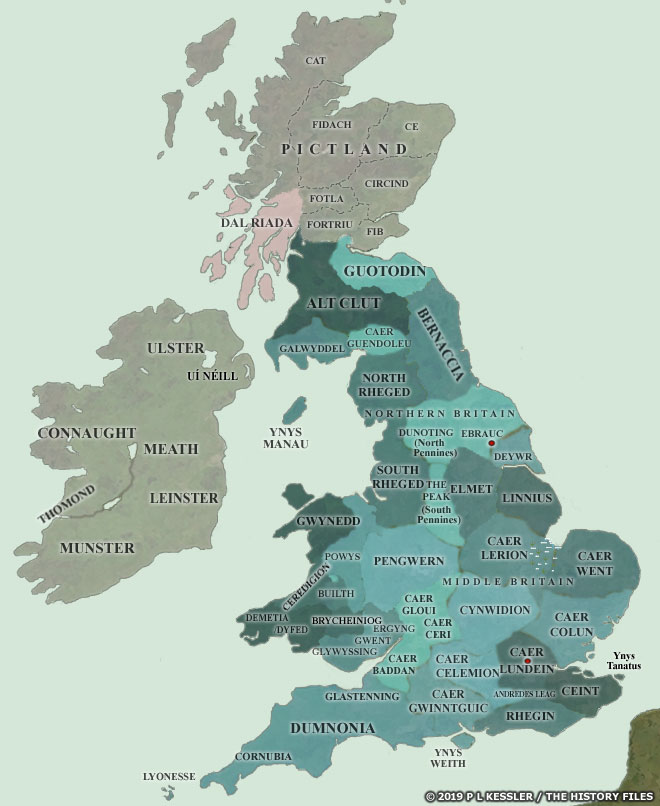 This map of Britain concentrates on British territories and kingdoms which were established during the fourth and fifth centuries AD, as the Saxons and Angles began their settlement of the east coast (click or tap on map to view full sized) This map of Britain concentrates on British territories and kingdoms which were established during the fourth and fifth centuries AD, as the Saxons and Angles began their settlement of the east coast (click or tap on map to view full sized) |
|
|
| He is called 'the Imperator' ('emperor'), suggesting a man of real power, on a par with the imperial title which is presumed to be held by Vortigern from around this date, and probably by his immediate successors too. In British tradition, and noted in the lives of more than one of the saints, he marries the seemingly unnamed mother of Igerna (Eigr in Welsh) of Arthurian legend. Anblaud is father to Igerna and her sister, mothers to Arthur Pendragon and Culhwch respectively. |
|
|
| c.455 |
As the east of the island of Britain is engulfed by the chaos of the foederati revolt which sees the loss of Ceint, later tradition states that Vortimer is poisoned and his death temporarily allows Vortigern to reclaim control of the ruling council before he is faced by Ambrosius Aurelianus. Vortigern flees to his ancestral lands, 'at the fortified camp of Genoreu (Ganarew in later Welsh), on the hill called Cloartius (Little Doward, with its hilltop camp)', in Ercing, by the River Wye. There he meets his end when Ambrosius sets fire to his fortress with him inside it. 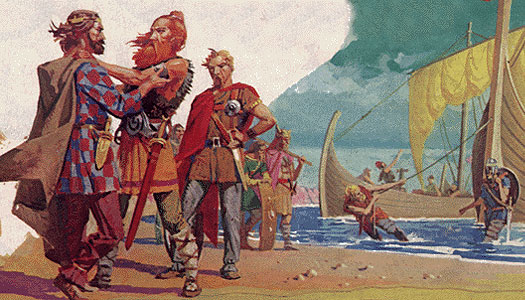 Vortigern's policy of hiring mercenaries to help with Britain's defences was entirely in line with those of the late Roman period, but the chaos in the country - plague, mercenary revolt, civil war, frequent pirate raids - probably convinced Hengist and Horsa (shown here being greeted by Vortigern) that land was ripe for the taking Vortigern's policy of hiring mercenaries to help with Britain's defences was entirely in line with those of the late Roman period, but the chaos in the country - plague, mercenary revolt, civil war, frequent pirate raids - probably convinced Hengist and Horsa (shown here being greeted by Vortigern) that land was ripe for the taking |
|
| fl c.474 |
Gwrfoddw Hen 'the Old' |
Son. Uncle to Arthur of Britain. Ercing taken from Ewyas? |
| Gwrfoddw Hen is linked through tradition to Arthur, the British battle leader of the late fifth century. An early seventh century prince who is also named Gwrfoddw is attested through a number of charters in the collected Llandaff Charters. This later Gwrfoddw is not named 'the Old' however, so the two are either being confused and merged, or the Arthurian example is a re-use of an historical figure. |
|
|
| The gap between Gwrfoddw Hen and Isbuius is hard to explain unless Ercing is not yet a territory in its own right. Potentially it is only later legendary materials which paint it as a principality in the fifth century. Perhaps instead it remains a region, theoretically part of Gwent, until Isbuius 'lord of Ercing' appears around the mid-sixth century to lay down the basis for a principality. |
|
|
| fl c.550? |
Isbuius / Yspwys? |
'Lord of Ercing'. |
| c.570s |
The genealogies are somewhat confused (and confusing) where a certain Yspwys Mwyntyrch ap Yspwys is concerned, as are modern descendant registers which may be based on those genealogies. 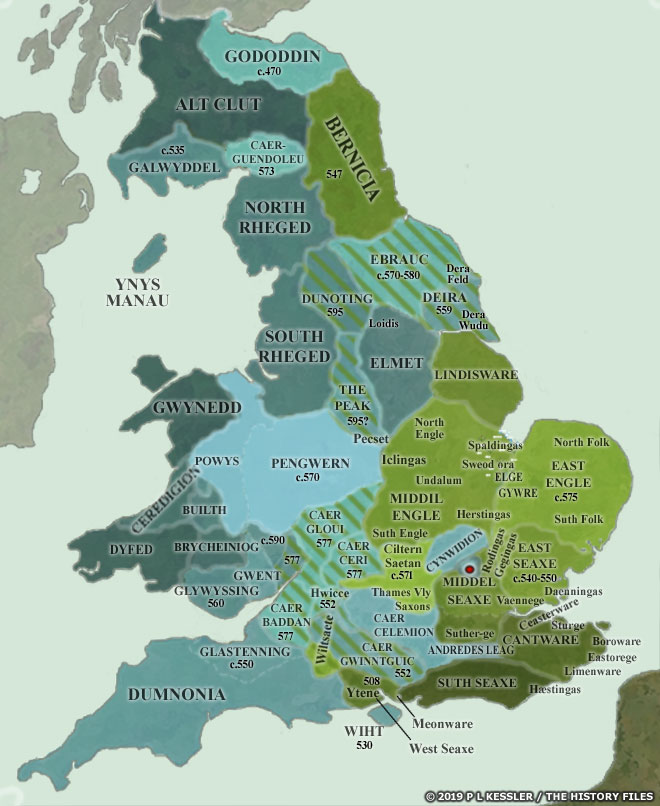 At the start of this period, the Angle and Saxon kingdoms on the east and south coasts were firmly established. Many of the rapidly-formed Romano-British territories in those areas had been swept away in the late fifth century (click or tap on map to view full sized) At the start of this period, the Angle and Saxon kingdoms on the east and south coasts were firmly established. Many of the rapidly-formed Romano-British territories in those areas had been swept away in the late fifth century (click or tap on map to view full sized) |
|
| He could be a late ruler of Calchwynedd or he could just as easily be a noble of Ercing. His father is Esbwys (Yspwys) ap Cadrod, which makes him the grandson of Cadrod of Calchwynedd, but then the title 'lord of Ercing' is added, which is nowhere near Calchwynedd. It is acknowledged, though, that the Cadrod in question could either be the son of Cynwyd or one Enir Fardd who himself has debatable links to Ercing. It seems more likely that two individual figures with the name Yspwys have been confused and combined - with one in Ercing who may appear a century before the one in Calchwynedd. Although the Welsh genealogies have only preserved a very Welsh version of the name, in Latin it would be Isbuius, and a Brythonic version of this is likely to be used in the Chilterns. |
|
|
| fl c.570 |
Glywys |
Son? His daughter married Prince Meurig of Gwent. |
| c.590 - c.610 |
The principality falls under the rule of Gwent (or returns to being a region within Gwent). Mentioned around 580 during his reign, Meurig ap Caradog of Gwent is passed the combined principality of Gwynllg & Penychen by his nephew by marriage, Catocus.His own marriage to the daughter of Glywys of Ercing also means that his son inherits that principality. His grandson, Erb ap Erbic, in holding onto these territories, is dubbed the 'King of South-East Wales'. 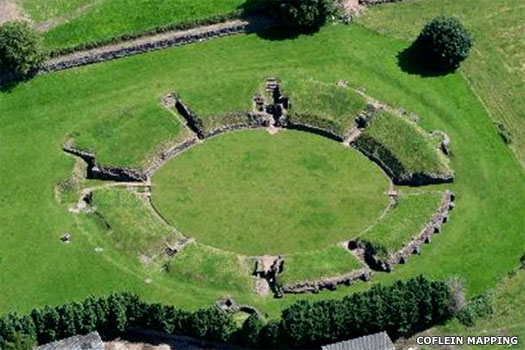 The amphitheatre of the legionary fortress at Caerleon survived as an earthwork and was known as 'King Arthur's Round Table', being excavated amid a blaze of publicity in 1926-1927 and subsequently being preserved for public view The amphitheatre of the legionary fortress at Caerleon survived as an earthwork and was known as 'King Arthur's Round Table', being excavated amid a blaze of publicity in 1926-1927 and subsequently being preserved for public view |
|
| fl c.590 |
Erbic ap Meurig |
Son-in-law. Ruler of Gwent,Glywyssing, & Ercing. |
| fl c.595 |
Erb ap Erbic |
Son. Holds Gwent, Glywyssing, & Ercing. 'King of S-E Wales'. |
| c.610 |
Upon Erb's death the unified principality of Gwent and Ercing is divided between his sons, nullifying the achievement of unification. Nynnio gains Gwent, while the younger Pebiaw gains Ercing. |
|
| fl c.610 |
Pebiaw Gladrog 'the Leprous' ap Erb |
Son. m dau of Constantine of Dumnonia. |
Pebiaw Gladrog (or Peibio Claforg) has a daughter named Efrddyl. She gives birth to an illegitimate son named Dubricius who becomes the bishop of Ercing of the British Church at an unknown date and resigns around 545, dying in 550 (quite early for the timeline given here). Geoffrey of Monmouth has him distinctly out of his time, showing him as the fictitious archbishop of the City of the Legions (Caerleon), although even the known dating for him fails to match up entirely to the rough dates of rule for Pebiaw and his successor. 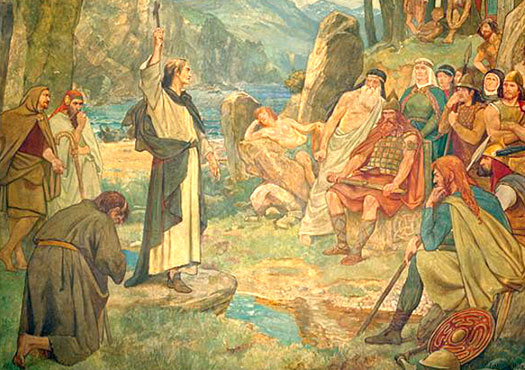 St Columba's mission to the Scots of Dál Riata and the Picts of northern Britain greatly expanded the reach of the Celtic church, with this oil of his meeting with the Picts being painted in 1898 by William Brassey Hole St Columba's mission to the Scots of Dál Riata and the Picts of northern Britain greatly expanded the reach of the Celtic church, with this oil of his meeting with the Picts being painted in 1898 by William Brassey Hole |
|
|
| ? - c.615 |
Conbinus / Cynfyn ap Peibio |
Son. Possibly joint ruler with brother, Gwyddgi. |
| Cynfyn is largely unknown, but he is mentioned on a couple of charters which confirm his role as ruler of Ercing and which are linked to the British Church. Those mentions are both in the collected Llandaff Charters, the second in a land grant to Bishop Aeddan of Gwent & Ercing (who dies around 608), and the first in a charter which can be linked to Bishop Elwystl of Gwent & Ercing (prominent in the late sixth century). Unfortunately those dates would appear to contradict the calculations given here for other princes who precede him. |
|
|
| c.615 - 619 |
Gwrfoddw |
Usurper. Mentioned in Llandaff Charters. Died. |
| fl c.619 - 645 |
Gwrgant Mawr 'the Great' |
Son of Cynfyn. Regained throne. Died circa 645? |
| c.650 |
Gwent and Ercing are once more reunited under the rule of the energetic Meurig ap Tewdrig of Gwent, and Ercing (or Ergyng) becomes a cantref to that principality. By this time, the Hwicce are probably pushing at Ercing's borders, so its existence as an independent principality is unlikely to last for much longer anyway. 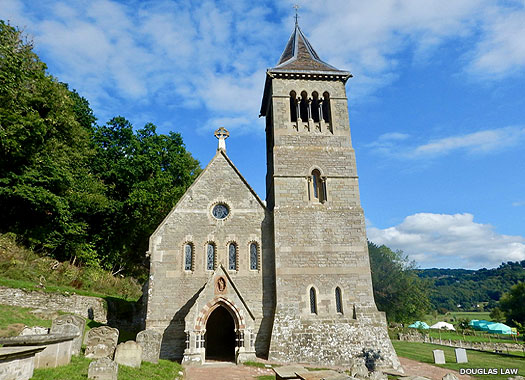 The Church of St Margaret, Welsh Bicknor, lies in territory in southern Herefordshire which is highly likely to have belonged to Ercing until the middle of the seventh century AD (click or tap on image to read more about this church) The Church of St Margaret, Welsh Bicknor, lies in territory in southern Herefordshire which is highly likely to have belonged to Ercing until the middle of the seventh century AD (click or tap on image to read more about this church) |
|
| By the ninth century Ercing has been conquered by Mercia, although rather than being entirely subjugated its Welsh inhabitants enjoy special rights. In 1535 and 1542, two acts of Parliament draw much of it into the county of Herefordshire. |
|
|
 |
|
|
 With the expulsion of Roman officials in AD 409 (see feature link), Britain again became independent of Rome and was not re-occupied. The fragmentation which had begun to emerge towards the end of the fourth century now appears to have accelerated, with minor princes, newly declared kings, and Roman-style magistrates all vying for power and influence while also facing the threat of extinction at the hands of the various barbarian tribes which were encroaching from all sides.
With the expulsion of Roman officials in AD 409 (see feature link), Britain again became independent of Rome and was not re-occupied. The fragmentation which had begun to emerge towards the end of the fourth century now appears to have accelerated, with minor princes, newly declared kings, and Roman-style magistrates all vying for power and influence while also facing the threat of extinction at the hands of the various barbarian tribes which were encroaching from all sides.  In the west, largely in what would become modern Wales, this process seems to have started earlier and taken place more quickly. Even by the start of the fifth century it is apparent that several territories had emerged here. The process seems to have been triggered by the reorganisations of Magnus Maximus in the late fourth century (see feature link), with what later tradition would claim as the creation of the 'kingdoms' of 'North Wales', 'South Wales', and 'Mid-South Wales'.
In the west, largely in what would become modern Wales, this process seems to have started earlier and taken place more quickly. Even by the start of the fifth century it is apparent that several territories had emerged here. The process seems to have been triggered by the reorganisations of Magnus Maximus in the late fourth century (see feature link), with what later tradition would claim as the creation of the 'kingdoms' of 'North Wales', 'South Wales', and 'Mid-South Wales'.  Largely defined by tradition (especially The Mabinogion - see feature link), genealogies, and Geoffrey of Monmouth, the small principality of Ercing (or Ergyng in later records) was located to the south of the Paganes territory, and to the east of Gwent. Today its territory lies within the southern parts of Hereford, the northern parts of Monmouth, and to the west of the River Wye.
Largely defined by tradition (especially The Mabinogion - see feature link), genealogies, and Geoffrey of Monmouth, the small principality of Ercing (or Ergyng in later records) was located to the south of the Paganes territory, and to the east of Gwent. Today its territory lies within the southern parts of Hereford, the northern parts of Monmouth, and to the west of the River Wye.  That tradition suggests that Ercing could have become independent under Gwrfoddw Hen in the late fifth century AD. Until then it appears to have been regarded as part of the territory of Gwent, and before that a domain of Eudaf Hen, ruler of the Silures Britons of Ewyas in the early fourth century (see feature link). Through intermarriage it twice later became rejoined to Gwent, the second time being the final time. Its capital was seemingly at Caer Aricon (now known as Weston-under-Penyard). As with many other Brythonic states of the post-Roman period, from the start this principality took the name of its capital town. Rapid language shifts soon amended the pronunciation of 'Aricon' into 'Arcing' or 'Ercing' and then 'Ergyng'. The English name of Archenfield is a direct translation of this, and the region retained a deeply-ingrained Welsh cultural tone as late as the reign of the Tudor dynasty in Britain. It should also be noted that the Brythonic language has gone through five stages to reach modern Welsh: 'Primitive' (in the 500s-700s), Old Welsh (in the 800s-1000s), Middle Welsh (in the 1100s-1400s), 'Early Modern' (in the 1400s-1700s), and 'Late Modern' thereafter. Until the Middle Welsh period, the word 'caer' was actually 'cair', from the Brythonic 'cajr', meaning 'fort, fortified place'.
That tradition suggests that Ercing could have become independent under Gwrfoddw Hen in the late fifth century AD. Until then it appears to have been regarded as part of the territory of Gwent, and before that a domain of Eudaf Hen, ruler of the Silures Britons of Ewyas in the early fourth century (see feature link). Through intermarriage it twice later became rejoined to Gwent, the second time being the final time. Its capital was seemingly at Caer Aricon (now known as Weston-under-Penyard). As with many other Brythonic states of the post-Roman period, from the start this principality took the name of its capital town. Rapid language shifts soon amended the pronunciation of 'Aricon' into 'Arcing' or 'Ercing' and then 'Ergyng'. The English name of Archenfield is a direct translation of this, and the region retained a deeply-ingrained Welsh cultural tone as late as the reign of the Tudor dynasty in Britain. It should also be noted that the Brythonic language has gone through five stages to reach modern Welsh: 'Primitive' (in the 500s-700s), Old Welsh (in the 800s-1000s), Middle Welsh (in the 1100s-1400s), 'Early Modern' (in the 1400s-1700s), and 'Late Modern' thereafter. Until the Middle Welsh period, the word 'caer' was actually 'cair', from the Brythonic 'cajr', meaning 'fort, fortified place'.
 This map of Britain concentrates on British territories and kingdoms which were established during the fourth and fifth centuries AD, as the Saxons and Angles began their settlement of the east coast (click or tap on map to view full sized)
This map of Britain concentrates on British territories and kingdoms which were established during the fourth and fifth centuries AD, as the Saxons and Angles began their settlement of the east coast (click or tap on map to view full sized) Vortigern's policy of hiring mercenaries to help with Britain's defences was entirely in line with those of the late Roman period, but the chaos in the country - plague, mercenary revolt, civil war, frequent pirate raids - probably convinced Hengist and Horsa (shown here being greeted by Vortigern) that land was ripe for the taking
Vortigern's policy of hiring mercenaries to help with Britain's defences was entirely in line with those of the late Roman period, but the chaos in the country - plague, mercenary revolt, civil war, frequent pirate raids - probably convinced Hengist and Horsa (shown here being greeted by Vortigern) that land was ripe for the taking At the start of this period, the Angle and Saxon kingdoms on the east and south coasts were firmly established. Many of the rapidly-formed Romano-British territories in those areas had been swept away in the late fifth century (click or tap on map to view full sized)
At the start of this period, the Angle and Saxon kingdoms on the east and south coasts were firmly established. Many of the rapidly-formed Romano-British territories in those areas had been swept away in the late fifth century (click or tap on map to view full sized) The amphitheatre of the legionary fortress at Caerleon survived as an earthwork and was known as 'King Arthur's Round Table', being excavated amid a blaze of publicity in 1926-1927 and subsequently being preserved for public view
The amphitheatre of the legionary fortress at Caerleon survived as an earthwork and was known as 'King Arthur's Round Table', being excavated amid a blaze of publicity in 1926-1927 and subsequently being preserved for public view St Columba's mission to the Scots of Dál Riata and the Picts of northern Britain greatly expanded the reach of the Celtic church, with this oil of his meeting with the Picts being painted in 1898 by William Brassey Hole
St Columba's mission to the Scots of Dál Riata and the Picts of northern Britain greatly expanded the reach of the Celtic church, with this oil of his meeting with the Picts being painted in 1898 by William Brassey Hole The Church of St Margaret, Welsh Bicknor, lies in territory in southern Herefordshire which is highly likely to have belonged to Ercing until the middle of the seventh century AD (click or tap on image to read more about this church)
The Church of St Margaret, Welsh Bicknor, lies in territory in southern Herefordshire which is highly likely to have belonged to Ercing until the middle of the seventh century AD (click or tap on image to read more about this church)